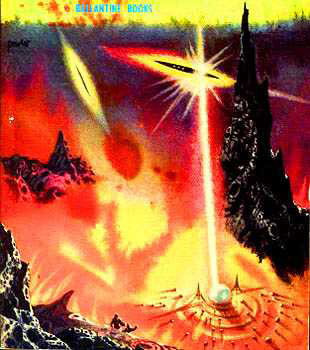DARPA Works to Perfect Self-Forging, High-Velocity 'Spears'

In his 1955 novel Earthlight, science fiction authorArthur C. Clarke thought of an incredible superweapon that used giantelectromagnets to shoot a stream of molten metal at lightning speed. Now, theDefense Advanced Research Projects Agency (DARPA)wants one for America's military.
They are calling it MAHEM, which stands for MagnetoHydrodynamic Explosive Munition. The intent is to create a device that createsa powerful enough electromagnetic field to propel streams of molten metal atenemy armor. If it works, the device will be a big improvement on a technologythat got its start in World War II — the self-forging penetrator.
Self-forging penetrators, as they are currently used, resultfrom a conventional chemical explosion directed against a specially-shapedmetal liner. When the device is set off, the blast causes the metal liner toachieve a new shape, suitable for penetrating deep into even moderately armoredvehicles, and driven forward at a high velocity. The technology dates back toWWII.
This kind of weapon can be highly effective (it is currentlybeing used against troops in Iraq). The drawbacks of this kind of weapon fromthe standpoint of US military planners is that they are one-time-use weapons,and cannot efficiently form multiple SFPs from a single charge.
If it is possible to use a powerful electromagnet toaccelerate a molten jet of metal, it could overcome the drawbacks mentionedabove, and even achieve higher velocities and better targeting. DARPA hopesthat it could provide the following capabilities:
"This could provide the warfighter with a means toaddress stressing missions such as: lightweight active self-protection forvehicles (potential defeat mechanism for a kinetic energy round), counter armor(passive, reactive, and active), mine countermeasures, and anti-ship cruise missilefinal layer of defense."
Science fiction readers wonder what took DARPA planners solong; we've known about this idea for more than a half-century. In Earthlight,Arthur C. Clarke makes use of exactly this idea in a battle between astationary facility on the Moon and several attacking space ships, includingthe aptly named Lethe.
Get the Space.com Newsletter
Breaking space news, the latest updates on rocket launches, skywatching events and more!
Listen to the incomparable Clarke describe the battle foryou, which takes place in the Sea of Rains.
"Inutter silence, the battle was rising to its climax. Millions of years ago themolten rock had frozen to form the Sea of Rains, and now the weapons of theships were turning it once more to lava. Out by the fortress, clouds ofincandescent vapor were being blasted into the sky ...
"Wheelersaw it strike upward, a solid bar of light stabbing at the stars... He did nothave time to reflect on the staggering violation of the laws of optics whichthis phenomenon implied, for he was staring at the ruined ship above his head.The beam had gone through Letheas if she did not exist; the fortress had speared her as an entomologistpierces a butterfly with a pin."
(Read more about the stiletto beam;see illustrativebook cover.)
The "beam" was a molten jet of metal hurled intospace by enormous electromagnets.
This is not the only example of science-fictional weaponry sought by US government agencies:
Ghostbuster Approach To Neutralizing WMD
You knew that someday it would come to this; Homeland Security calls upon Ghostbuster tech.
Navy EMRG Hypervelocity Projectiles
This weapon can even strike targets on the other side of mountains.
Via MAgneto Hydrodynamic Explosive Munition (MAHEM); see also this tribute to Clarke, who died at age 90 last month.
(This ScienceFiction in the News story used with permission of Technovelgy.com)
- VIDEO: Arthur C. Clarke ? To Plan For A Century
- Science Fiction Writer Arthur C. Clarke Dies at Age of 90
- DARPA's 'Star Wars'-style Laser Cannon
Join our Space Forums to keep talking space on the latest missions, night sky and more! And if you have a news tip, correction or comment, let us know at: community@space.com.
Bill Christensen is the founder and editor of Technovelgy, a website dedicated to cataloguing the inventions, technology and ideas of science fiction writers. Bill is a dedicated reader of science fiction with a passion about science and the history of ideas. For 10 years, he worked as writer creating technical documentation for large companies such as Ford, Unisys and Northern Telecom and currently works to found and maintain large websites. You can see Bill's latest project on Twitter.









